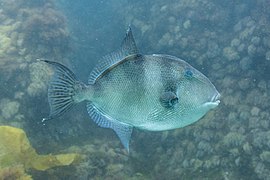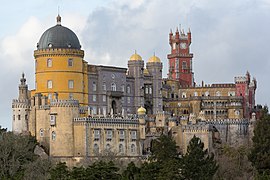Portal:Portugal
Welcome to the Portugal portal  Portugal, officially the Portuguese Republic, is a country in the Iberian Peninsula in Southwestern Europe. Featuring the westernmost point in continental Europe, Portugal borders Spain to its north and east, with which it shares the longest uninterrupted border in the European Union; to the south and the west is the North Atlantic Ocean; and to the west and southwest lie the Macaronesian archipelagos of the Azores and Madeira, which are two autonomous regions of Portugal. Lisbon is the capital and largest city, followed by Porto, which is the only other metropolitan area. The western part of the Iberian Peninsula has been continuously inhabited since prehistoric times, with the earliest signs of settlement dating to 5500 BC. Celtic and Iberian peoples arrived in the first millennium BC. The region came under Roman control in the second century BC, followed by a succession of Germanic peoples and the Alans from the fifth to eighth centuries AD. Muslims conquered the entirety of Portugal's current mainland in the eighth century, but they were gradually expelled by the Christian Reconquista over the next several centuries. Modern Portugal began taking shape during this period, initially as a county of the Christian Kingdom of León in 868, officially declared a sovereign Kingdom with the Treaty of Zamora in 1143. During the Age of Discovery, the Kingdom of Portugal settled Madeira and the Azores, and established itself as a major economic and political power, largely through its maritime empire, which extended mostly along the South Atlantic and Indian Ocean coasts. Portuguese explorers and merchants were instrumental in establishing trading posts and colonies that enabled control over spices and slave trades. While Portugal expanded its influence globally, its political and military power faced internal and external challenges towards the end of the 16th century. The dynastic crisis marked the beginning of the country's political decline that led to the Iberian Union (1580-1640), a period in which Portugal was united under Spanish rule. While maintaining a degree of self-governance, the union strained Portugal’s autonomy and drew it into conflicts with European powers which targeted Portuguese territories and trade routes. Portugal's prior opulence was further diminished by a series of events, such as the Portuguese Restoration War and the 1755 Lisbon earthquake, which destroyed the city and damaged the empire's economy. (Full article...) Selected article -Santa Cruz is a former civil parish in the municipality of Coimbra, Portugal. In 2013, the parish merged into the new parish Coimbra (Sé Nova, Santa Cruz, Almedina e São Bartolomeu). In 2001, its population was 6866 inhabitants, in an area of 5.56 km2 that parallels the north (right) margin of the Mondego River, extending to the village of Adémia in Trouxemil (its density is approximately 1235 inhabitants per km2). (Full article...) This is a Featured article, which represents some of the best content on English Wikipedia.  The national flag of the Portuguese Republic, often referred to as the Portuguese flag consists of a rectangular bicolour with a field divided into green on the hoist, and red on the fly. A lesser version of the country’s national coat of arms stands in the middle of the Portuguese armillary sphere and shield, centered over the colour boundary at equal distance. The flag was announced in 1910, following the 5 October 1910 revolution, inspired by the colours of the Republican Party and the design of radical conspiratorial society Carbonária. Its presentation was done on 1 December 1910, after the downfall of the constitutional monarchy on 5 October 1910. However, it was only on 30 June 1911, that the official decree approving this flag as the official flag was published. This new national flag for the First Portuguese Republic, was selected by a special commission whose members included Columbano Bordalo Pinheiro, João Chagas and Abel Botelho. The conjugation of the new field color, especially the use of green, was not traditional in the Portuguese national flag's composition and represented a radical republican-inspired change that broke the bond with the former monarchical flag. Since a failed republican insurrection on 31 January 1891, red and green had been established as the colours of the Portuguese Republican Party and its associated movements, whose political prominence kept growing until it reached a culmination period following the Republican revolution of 5 October 1910. In the ensuing decades, these colours were popularly propagandised, green represented the hope of the nation and the colour red represented the blood of those who died defending it, this happened to endow them with a more patriotic and dignified, therefore less political, sentiment. (Full article...) General imagesThe following are images from various Portugal-related articles on Wikipedia. Selected quote -"Be plural like the universe!"
Sê plural, como o Universo! This is a Good article, an article that meets a core set of high editorial standards.  Caldas da Rainha (European Portuguese: [ˈkaldɐʒ ðɐ ʁɐˈiɲɐ] ) is a medium-sized Portuguese city in the Oeste region, in the historical province of Estremadura, and in the district of Leiria. The city serves as the seat of the larger municipality of the same name and of the Comunidade Intermunicipal do Oeste (OesteCIM, Intermunicipal Community of the West). At the 2011 census, the municipality had a population of 51,729 in an area of 255.69 square kilometres (98.72 sq mi), with 30,343 residing in the city. Although the city itself lies about 10.5 kilometres (6.5 mi) inland, three of the municipality's civil parishes lie on the Atlantic Ocean. Caldas da Rainha is best known for its sulphurous hot springs and ceramic pottery. The settlement was founded in the 15th century by Queen Leonor (Rainha Dona Leonor), who established a hospital and a church at the site of some therapeutic hot springs. The Hospital Termal Rainha D. Leonor (Queen Leonor Spring Water Hospital, or Thermal Hospital) is the oldest purpose-built institution of its kind in the world, with five centuries of history. The city's name, often shortened to simply "Caldas", can be translated as "Queen's Hot Springs", "Queen's Spa", or "Queen's Baths". (Full article...) Selected Biography -John I (Portuguese: João [ʒuˈɐ̃w̃]; 11 April 1357 – 14 August 1433), also called John of Aviz, was King of Portugal from 1385 until his death in 1433. He is recognized chiefly for his role in Portugal's victory in a succession war with Castile, preserving his country's independence and establishing the Aviz (or Joanine) dynasty on the Portuguese throne. His long reign of 48 years, the most extensive of all Portuguese monarchs, saw the beginning of Portugal's overseas expansion. John's well-remembered reign in his country earned him the epithet of Fond Memory (de Boa Memória); he was also referred to as "the Good" (o Bom), sometimes "the Great" (o Grande), and more rarely, especially in Spain, as "the Bastard" (Bastardo). (Full article...) Selected picture - A Portuguese F-84 being loaded with amunition in the 60's, at the Luanda Air Base, during the Portuguese Colonial War Did you know -
Portugal topicsPortugal lists
SubcategoriesRecognized contentFeatured articlesFormer featured articlesFeatured listsFormer featured listsGood articles
Former good articlesDid you know? articles
Featured pictures
Former featured portalsIn the News articles
Main page featured articles
Picture of the day pictures
Featured topicsNew articlesThis list was generated from these rules. Questions and feedback are always welcome! The search is being run daily with the most recent ~14 days of results. Note: Some articles may not be relevant to this project.
Rules | Match log | Results page (for watching) | Last updated: 2024-12-20 21:55 (UTC) Note: The list display can now be customized by each user. See List display personalization for details.
Things you can doRelated PortalsRelated WikiProjects
Associated WikimediaThe following Wikimedia Foundation sister projects provide more on this subject:
Discover Wikipedia using portals Purge server cache |




















![Image 18Maios celebration in Madeira island [1] (from Culture of Portugal)](https://upload.wikimedia.org/wikipedia/commons/thumb/e/e1/2011-03-05_03-13_Madeira_045_Santana_%285543431418%29.jpg/120px-2011-03-05_03-13_Madeira_045_Santana_%285543431418%29.jpg)



























































































